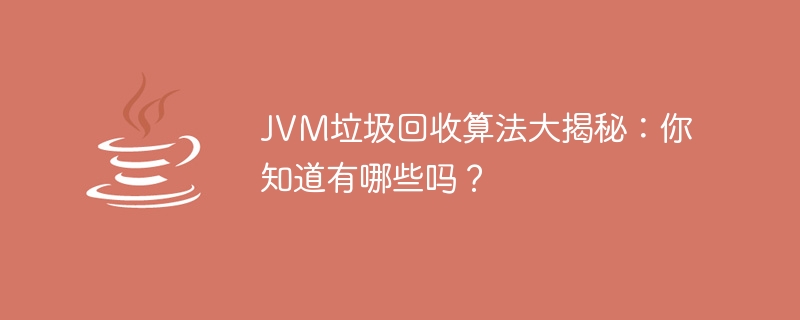Home >Java >javaTutorial >Revealing the secrets of JVM garbage collection algorithm: What do you know about it?
Revealing the secrets of JVM garbage collection algorithm: What do you know about it?
- WBOYWBOYWBOYWBOYWBOYWBOYWBOYWBOYWBOYWBOYWBOYWBOYWBOriginal
- 2024-02-18 14:00:111107browse

JVM Garbage Collection Algorithm Revealed: Do you know which ones are there?
JVM (Java Virtual Machine) is one of the tools most familiar and used by Java programmers. Garbage Collection, as an important function of the JVM, automatically manages memory allocation and release, eliminating the need for developers to manually manage memory, which greatly improves development efficiency and code quality.
However, the specific implementation of the garbage collection algorithm in the JVM is an issue that has attracted much attention and exploration. Proper garbage collection algorithms can greatly impact application performance and resource utilization. Below we will reveal several common JVM garbage collection algorithms and give corresponding code examples.
- Mark-Sweep Algorithm (Mark and Sweep)
The Mark-Sweep algorithm is one of the most basic garbage collection algorithms. The basic idea is to first mark all active objects and then clear all unmarked objects. The following is a code example of a simple mark-sweep algorithm:
public class MarkAndSweep {
public void mark(Object obj) {
if (obj.marked) return;
obj.marked = true;
for (Object ref : obj.references) {
mark(ref);
}
}
public void sweep() {
for (Object obj : heap) {
if (!obj.marked) {
heap.remove(obj);
} else {
obj.marked = false;
}
}
}
public void gc() {
mark(rootObject);
sweep();
}
}- Copying algorithm (Copying)
The copying algorithm is a garbage collection algorithm based on space for time. The core idea is to divide the memory into two blocks, and only use one of them at a time. When this block of memory is full, copy all surviving objects to another unused block of memory, and then clear the currently used memory. The following is a code example of a simple copy algorithm:
public class Copying {
public void gc() {
int from = 0;
int to = 1;
int size = heapSize / 2;
for (int i = 0; i < heapSize; i++) {
Object obj = heap[i];
if (obj.marked) {
heap[to] = obj;
to++;
}
}
for (int i = 0; i < heapSize; i++) {
heap[i].marked = false;
}
int temp = from;
from = to;
to = temp;
}
}- Mark-Copy Algorithm (Mark and Copy)
The Mark-Copy algorithm is a combination of the Mark-Sweep algorithm and Garbage collection algorithm for copying algorithms. The idea is to first mark all live objects, then copy all surviving objects to another unused memory, and then clear the currently used memory. The following is a code example of a simple mark-copy algorithm:
public class MarkAndCopy {
public void mark(Object obj) {
if (obj.marked) return;
obj.marked = true;
for (Object ref : obj.references) {
mark(ref);
}
}
public void copy(Object obj) {
if (!obj.marked) return;
obj.marked = false;
Object newObj = obj.copy();
for (Object ref : newObj.references) {
copy(ref);
}
}
public void gc() {
mark(rootObject);
copy(rootObject);
}
}The above is only one of the three common JVM garbage collection algorithms. Each algorithm has different advantages and disadvantages in different scenarios. , it is necessary to choose an appropriate garbage collection algorithm according to the specific situation. For developers, knowing and understanding the principles and implementation of these garbage collection algorithms can help better optimize program performance and save resources.
I hope this article can help readers have a deeper understanding of the JVM garbage collection algorithm and make more reasonable choices and optimizations in actual development.
The above is the detailed content of Revealing the secrets of JVM garbage collection algorithm: What do you know about it?. For more information, please follow other related articles on the PHP Chinese website!

